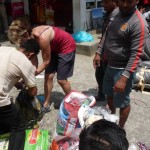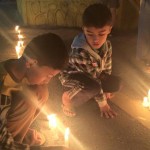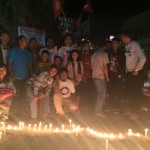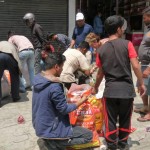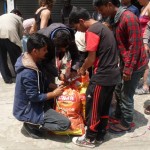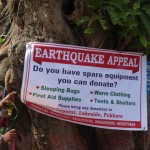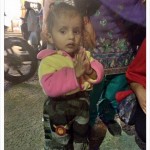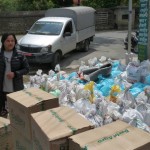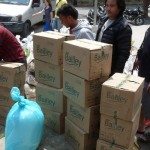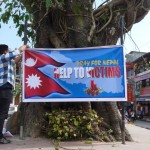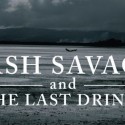[dropcap]F[/dropcap]oreign aid money and manpower are being stretched to capacity as relief organisations scramble to provide vital assistance to the millions injured and displaced by the catastrophic 7.8 magnitude earthquake that struck Nepal’s Kathmandu Valley last Saturday.
Killing at least 6,000, and injuring more than 10,000, Nepal’s biggest earthquake in 80 years rocked the country just six weeks after the Category 5 Cyclone Pam devastated the Pacific nation of Vanuatu, posing further logistical challenges for aid organisations distributing relief.
“The craziest thing was knowing they [the aftershocks] were coming because we were sitting at the lake and before each aftershock you would see a wall of birds just fly over the lake because they feel it before the humans feel it.”
Chloé Grayson, a 29-year-old Canadian studying in Nepal to be a yoga instructor, described her distressing ordeal when the violent shaking begun.
“We were on the second floor of the yoga hall…and all of a sudden the building just started to go, and I don’t even think my feet hit the floor, I was up and out of there. I just ran onto the main lawn.
“I never thought in my life that I would have to face death that way or have my life flash before my eyes. I was looking up thinking…if that shaking would’ve gone on any longer, we would’ve been done.”
Prior to arriving in Nepal in early April, Ms Grayson had spent two years teaching English in Osaka, Japan where she experienced mild tremors, but nothing on the scale of the Kathmandu quake.
“It was difficult to stand up. It lasted for…it felt like forever, I think it was about a minute or two and it stopped and I ran to the lakeside…and from there we rode out about three aftershocks that were really heavy.
“I think the craziest thing was knowing they [the aftershocks] were coming because we were sitting at the lake and before each aftershock, you would see a wall of birds just fly over the lake because they feel it before the humans feel it,” she said.
Studying in the tourist town of Pokhara, Ms Grayson said she feels very lucky not to have experienced the disaster in Kathmandu.
“In geological time, I missed that by a minute. I was in Kathmandu three weeks before to the day…I was in Durbar Square at lunch time having lunch, and three Saturdays later…
“I looked at photos and every single photo that I took – it’s all gone. Everything is gone,” she said.
Ms Grayson said that in Pokhara there is a ready supply of food, fresh water, and shelter, and the situation is relatively safe.
“I’ve been hearing in Kathmandu they’re fighting for food and water right now because there’s nothing. They can’t get anything,” she said.
The United Nations Wednesday launched a $415 million emergency appeal to provide critical aid to people affected by the quake.
Aid Priority Concerns Arise in Vanuatu Post Nepal Quake
While aid organisations are attempting to scale up relief efforts to help millions of Nepalis, the Pacific nation of Vanuatu is still battling in its recovery efforts after being pummelled by Category 5 Cyclone Pam less than two months ago.
Killing 16 and leaving thousands homeless, the cyclone waged destruction across the nation flattening tree crops, ripping gardens apart, destroying houses, and contaminating drinking water.
“At some point Vanuatu just falls off the news reports, and the people who donated have done their little bit, and there’s another disaster somewhere else in the world and they’ll just get forgotten.”
Nepal’s Kathmandu Valley quake was the natural disaster Vanuatu residents dreaded, as help from aid organisations is still badly needed for the recovery effort on more than 20 of the country’s 83 islands.
Australian tourist, Sophie Wilksch, who was in Vanuatu when the cyclone hit and stayed on to help the rebuilding effort on Pele island, said community leaders had been preparing the people for the possibility that Vanuatu soon would not be first priority when it came to foreign aid and donations.
“The council reps got together and had a big meeting with their community to remind their community that they can’t just wait for the help to come…They actually have to work really, really hard to look after themselves.
“Because at some point Vanuatu just falls off the news reports, and the people who donated have done their little bit, and there’s another disaster somewhere else in the world and they’ll just get forgotten,” she said.
Red Cross Operations Coordinator Nicolas Verdy countered this, however, saying the Red Cross has a long-term plan for staying to help the residents of Vanuatu.
“We have delegates right now on the ground [in Vanuatu] working which we didn’t re-route because something happened somewhere else.
“We’re in the recovery phase right now and we’re going to have a long-term program. Probably for Vanuatu, there will be a full-time delegation over there supporting the national society for at least the next two years, at least,” he said.
Mr Verdy said while Nepal is a big focus for the Red Cross now, this will not affect resources and efforts allocated to the situation in Vanuatu.
“We have a big team. Our movement is huge, it’s worldwide…Obviously the capacity is limited, but…every big meeting we have here, we remind ourselves what is happening in the rest of the world. I mean we’re still responding to floods in Malaysia, this operation didn’t stop, it’s out of the news completely.
“Vanuatu is a little bit out of the news as well but we still have key people. I’m supposed to be redeployed back to the Suva regional office and possibly to Vanuatu on Monday, for example, and I’m going to keep focusing on this,” he said.
Mr Verdy said the Red Cross will continue to closely monitor the situation on the ground in Vanuatu despite natural disasters occurring elsewhere.
“It’s huge for people in Nepal [the earthquake], but it’s also huge for people in Vanuatu what happened to them.”
“Take the amount of people who died, we’re at over 5,000 in Nepal. Then you take Vanuatu and the official number is 16. And then you would be tempted to say well Nepal is important, it’s a thousand times bigger so spend a thousand more hours on this. But this is not the case.
“It’s huge for the population of Vanuatu. We compared it to Haiyan and what happened last year in the Philippines. We said this is their Haiyan. This is going to be very difficult for them to get back up, brush it off, and continue living their normal lives,” he said.
Frustration Arising from “Slow” Relief Efforts
News reports from global media outlets describe survivors’ frustration in Nepal at the slow delivery of aid, a familiar sentiment in Vanuatu.
A public Facebook page set up two weeks after Cyclone Pam struck the archipelago by New Zealander Karen Murphy, who was one of the first responders on the southern island of Tanna, described the dire situation on the island, airing frustrations regarding the distribution delays of desperately-needed aid supplies.
“There are many aid agencies and the French and Australian army that have arrived in Tanna with stock piles of supplies yet, due to red tape, politics and too much paper shuffling…no one in Tanna has been given anything,” she wrote, more than two weeks after the devastation occurred.
Australian, Sophie Wilksch, described a similar situation on Pele island.
“When we got to Pele, we got there five days after the cyclone, and we were the first help to arrive… The Red Cross got there almost two weeks after the cyclone.
“The Red Cross did come, but they said they had to choose out of the 35 families that completely lost homes, they had to choose 20 that the Red Cross would support…it created a bit of a bad feeling within the community,” she said.
Responding to the criticisms, Patrick Fuller, Communications Manager for the International Federation of Red Cross based in Kuala Lumpur, said that for logistical reasons, it took six days for the government to authorize the aid agency to begin distributing relief.
“It was a week into this disaster that the government gave us permission to distribute relief after which we were designated specific areas in which we would work,” he said.
Mr Fuller explained that the government wanted to coordinate the work of the agencies to ensure the most-effective delivery of aid.
“Many international actors arrived in the country and the government wanted a well-coordinated response where different organisations were assigned specific responsibilities in different geographical areas according to their capacities.
“Bear in mind that the damage caused by Pam was spread across 22 islands. The Red Cross was the first organisation to begin distributing relief one week after the disaster when the government gave us the green light,” he said.
Regarding the situation on Pele, Mr Fuller said there were several logistical factors to consider.
“It could relate to the available relief materials the team had with them at the time. In the first couple of weeks when we first visited some of the affected islands we were carrying out distributions and assessments simultaneously which have meant that the team did not have sufficient relief materials for the entire affected community with them.
“Equally it could relate to the levels of vulnerability identified. Our primary focus is always on assisting the worst affected families first,” he said.
Mr Fuller said that while criticisms are understandable, there are many logistical challenges in disaster zones that can prevent immediate relief distribution on a large scale.
“It’s easy to criticise in these situations. There are many well-intentioned people out there who do good work in their communities after disasters and we consider them to be important players or ‘first responders.’
“What people fail to understand is that it’s possible to get relief in small amounts to a community relatively easily but operating on a much larger scale is far more complex,” he said.















